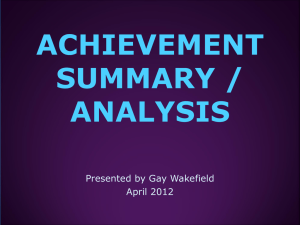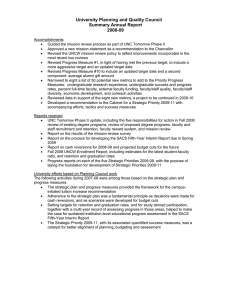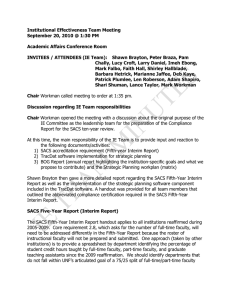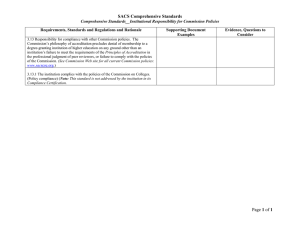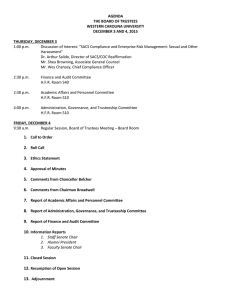Danielle Duffourc, Ph.D. Director for Institutional Effectiveness and Assessment Xavier University
advertisement
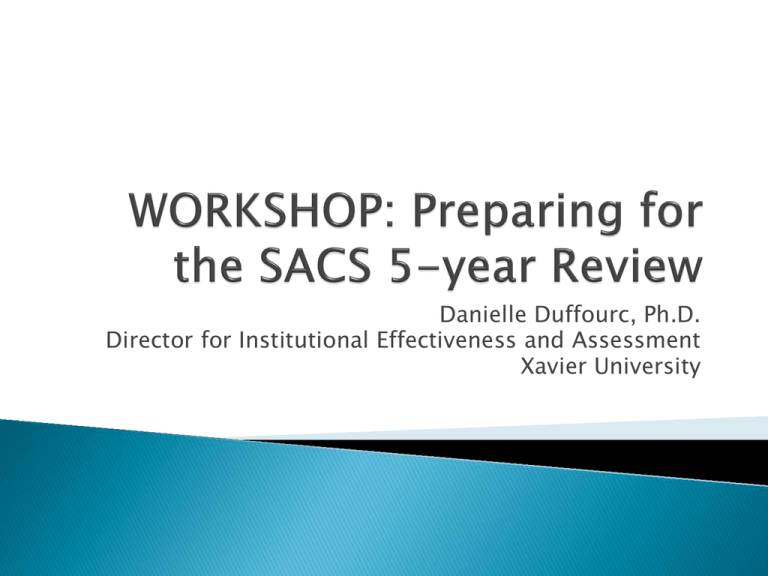
Danielle Duffourc, Ph.D. Director for Institutional Effectiveness and Assessment Xavier University Today’s workshop will focus on understanding the SACS expectations for Institutional Effectiveness in the 5 year interim report. ◦ What information do we need to have? ◦ What documentation do we need to have? ◦ Are there any other expectations? NOTIFICATION: Institutions are notified about eleven months prior to the due date for the report. SUBMISSION: Fifth-Year Interim Reports are submitted midMarch or mid-September. REVIEW: Report will be reviewed by the Fifth Year Interim Review Committee, which meets each June and December. RESULTS: A letter will go out to the reviewed institutions the following month, informing them of the results of the review. FOLLOW UP: ◦ If there are no issues for follow up—the process ends here. ◦ If there are issues, an institution would be asked to provide an additional report that will go to Compliance & Reports Committee, addressing the specific areas noted. 5-year Report ◦ April 2016 – Review Notification ◦ March 2017 – Report Due ◦ June 2017 – Report Reviewed 10-year Report ◦ June 2019 – Leadership Team to Atlanta ◦ September 2020 – Compliance Narrative Due ◦ Nov-Dec 2020 – Off-Site Review ◦ Jan-Feb 2021 – Focus Report and QEP Submission ◦ Jan-Mar 2021- On-Site Review ◦ December 2021 – Reaffirmation Decision Part I: Signatures Attesting to Integrity Part II: Abbreviated Institutional Summary Form Prepared for Commission Reviews Part III: Fifth-Year Compliance Certification Part IV: Additional Report (applicable only to select institutions) Part V: Impact Report of the Quality Enhancement Plan CR 2.8 CR 2.10 CS 3.2.8 CS 3.3.1.1 CS CS CS CS CS 3.13.3 CS 3.13.4 3.4.3 3.4.11 3.11.3 3.13.1 Number of Full-time Faculty Student Support Programs Qualified Administrators and Academic Officers Institutional Effectiveness: Educational Programs, to include Student Learning Outcomes Admissions Policies Qualified Academic Coordinators Physical Facilities Policy compliance: “Accrediting Decisions of Other Agencies” Policy compliance: “Complaint Procedures Against the Commission or Its Accredited Institutions” Policy compliance: “Reaffirmation of Accreditation and Subsequent Reports” FR 4.1 Student Achievement FR 4.2 Program Curriculum FR 4.3 Publication of Policies FR 4.4 Program Length FR 4.5 Student Complaints FR 4.6 Recruitment Materials FR 4.7/ Title IV Program Responsibilities and CS 3.10.2 Financial Aid Audits FR 4.8 Distance and correspondence education FR 4.9 Definition of credit hours The narrative and evidence for each standard should be as comprehensive as the narrative/evidence in your Compliance Certification Report. ◦ Follow all of the directions. ◦ Write clearly and succinctly, using pointed examples. ◦ Save the reader time by pointing directly to the specific supporting documentation - excerpting when it makes sense. CS 3.3.1.1 Institutional Effectiveness: Educational Programs, to include Student Learning Outcomes — 49% CR 2.8 Number of Full-time Faculty — 42% CS 3.4.11 Qualified Academic Coordinators — 32% CS 3.10.2/FR 4.7 Financial Aid/Title IV — 21% FR 4.5 Student Complaints — 17% The institution identifies expected outcomes, assesses the extent to which it achieves these outcomes, and provides evidence of improvement based on analysis of the results in the following area: 3.3.1.1 educational programs, to include student learning outcomes Relevant Questions for Consideration: ◦ How are expected outcomes clearly defined in measurable terms for each program? ◦ What assessment instruments were used and why were they selected? ◦ What is the evidence of assessment activities for each program? ◦ How are assessment results used for improvement? Common Issues ◦ Lack of defined student learning outcomes and/or methods for assessing the outcomes. ◦ Limited/Immature data. ◦ Not documenting use of data to make improvements. ◦ Non-representative sampling. ◦ Not addressing distance education and off-campus site programs. What needs to happen? ◦ Focus on educational programs and student learning outcomes. ◦ Use mature data. ◦ If using a new system, use data from the previous system, if necessary and possible, to demonstrate ongoing compliance. ◦ Document the use of data to make improvements. ◦ If presenting a sampling, use a representative sampling and include a rationale for what makes the sample reasonable and representative of the programs offered. ◦ Include data on programs offered at off-campus sites and via distance learning If I asked you to provide me with an argument for compliance that was backed up by multiple years of assessment data by the end of the day/week/month, could you? ◦ Does your department have defined outcomes and methods for assessing the outcomes? ◦ Does your department have a strong, consistent and welldocumented stream of data? ◦ Does your department do a good job of documenting use of data to make improvements? Provide an analysis of data, not just a data dump. Use tables and graphs when appropriate, along with narrative to help the reader understand what you are trying to illustrate. Connect the dots for the reader—remember you are translating, providing a context, and building a case for compliance Reviewers are looking to see that the academic programs… ◦ Have done what they said they were going to do and made reasonable adjustments to the plan along the way. ◦ Have measured and analyzed their impact on student learning. ◦ Have learned from the process. From the State of Assessment Report for 2012-13: ◦ 33 academic units: 16 units have attained SACS Compliance (48%) and 12 units have attained Process Compliance (36%). 5 units were noncompliant at the time of the review. ◦ 31 administrative and student support units: 18 units have attained SACS Compliance (58%) and 5 units have attained Process Compliance (16%). 8 units were non-compliant at the time of the review. Our overall goal is to have 100% SACS compliance in the academic units by the Fifth Year Report, and 100% SACS compliance in all units by the 10-year Review. ◦ This goal is critical to Xavier’s continued existence as a SACSCOC Accredited Institution. ◦ This goal is also important to departments as it provides evidence based proof of success, which has both intrinsic and extrinsic value. THE FIFTH-YEAR INTERIM REVIEW PROCESS & INCLUDED STANDARDS, Dr. Crystal A. Baird, Vice President http://www.sacscoc.org/staff/cbaird/FifthYear%20Interim%20Review.pdf
